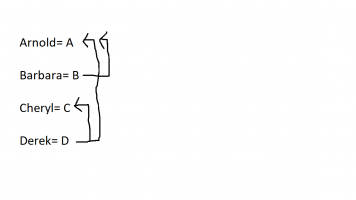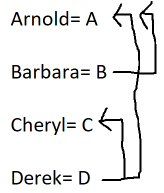As I said in your previous question, it frequently helps to use symbols. PKA has suggested using the formal symbolism of propositional calculus and truth tables for all such problems. Here is a cheat sheet.
I suggest that you read that until you are confident that you fully understand what it means. The problem with this cheat sheet is that it does not help with quantifiers. To get a basic understanding of those, look here:
Again study it unril it all makes sense.
Now I am not as confident as PKA that applying propositional calculus without training is as easy as he may think. Bur in this problem, you have affirmative and negative conditionals.
Do as PKA suggests and show what conditionals you know along with their negative equivalents.
[math]C \implies D \equiv \neg D \implies \neg C\\
\neg A \implies \neg D \equiv D \implies A \\
A \implies B \equiv \neg B \implies \neg A
[/math]
So you have six chains that you are to consider true
Your first problem starts with A. You have only one chain that starts with A, and it ends with B. Do you have any chains that start with B. No. So you cannot deduce anything about C from A.
Your second problem says no one will go. You have chains that end with not A, not C, and not D. You do not have a chain that ends with not B. So you cannot deduce that Barbara will not go so you cannot deduce that all will not go.
Your third problem says they all go. You have no chain that ends with C. So you cannot deduce C, which means you cannot deduce all will go.
Your fourth problem says if B is negative, then C is negative. We have only one chain that starts with [imath]\neg[/imath]B so we try starting there. That leads to [imath]\neg[/imath]A. We have only one chain that starts with [imath]\neg[/imath]A, and it leads to [imath]\neg[/imath]D. We have only one chain that starts with [math]\neg[/math]D.
So here is a chain we can build
[math]\neg B \implies \neg A \implies \neg N \implies \neg C[/math]
We can deduce that if B does not go, then C will not go.
This is very much brute force, and PKA can likely show you more elegant ways to do this exercise. But it does show how you can use the propositional calculus for such problems.
Your second problem






